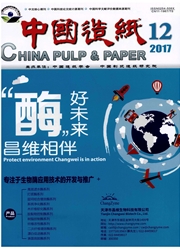

 中文摘要:
中文摘要:
以土壤杆菌、杆状菌、肠杆菌、戈登氏菌、恶臭假单胞菌和施氏假单胞菌为出发菌株,利用统计学分析方法分析筛选出对制浆废水降解作用显著的4株菌(土壤杆菌、杆状菌、戈登氏菌、恶臭假单胞菌);用筛选得到的优势降解菌群对好氧颗粒污泥进行强化,并用普通好氧颗粒污泥和强化后的好氧颗粒污泥对经厌氧活性污泥处理后的废水进行深度处理。结果表明,经普通好氧颗粒污泥和强化后的好氧颗粒污泥深度处理后,废水的CODCr由538 mg/L分别降为213和176 mg/L,色度由375度分别降为206和150度。
 英文摘要:
英文摘要:
In this experiment,six strains of bacteria,Agrobacterium sp.,Bacillus sp.,Enterobacter.Cloacae.,Gordonia sp.,Pseudomonas putida.and Pseudomonas stutzeri.were selected as the starting strains in pulping and papermaking wastewater treatment,from treatment efficiency point of view four of the strains Agrobacterium sp.,Bacillus sp.,Gordonia sp.and Pseudomonas putida.were chosen by using statistical analysis method.Then bioaugmentation of aerobic granular sludge was achieved successfully with adding these screened strains.The experiment results demonstrated that the CODCr and chroma of the effluent treated by bioaugumentaion system were 176 mg/L and 150 respectively,they were lower than the CODCr(213 mg/L) and chroma(206) of the effluent without bioaugumentaion system treatment.CODCr removal efficiency increased from 45.1% to 60.0% with bioaugumentaion system treatment.
 同期刊论文项目
同期刊论文项目
 同项目期刊论文
同项目期刊论文
 ENHANCED BIODEGRADATION OF PULPING EFFLUENTS BY A STATISTICAL EXPERIMENTAL DESIGN USING MICROBIAL CO
ENHANCED BIODEGRADATION OF PULPING EFFLUENTS BY A STATISTICAL EXPERIMENTAL DESIGN USING MICROBIAL CO Conversion of paper sludge to ethanol by separate hydrolysis and fermentation (SHF) using Saccharomy
Conversion of paper sludge to ethanol by separate hydrolysis and fermentation (SHF) using Saccharomy Changes in Pentachlorophenol (PCP) Metabolism and Physicochemical Characteristics by Granules Respon
Changes in Pentachlorophenol (PCP) Metabolism and Physicochemical Characteristics by Granules Respon Chemometrics-assisted spectrophotometry method for the determination of chemical oxygen demand in pu
Chemometrics-assisted spectrophotometry method for the determination of chemical oxygen demand in pu Optimization of Dilute Acid Pretreatment of Paulownia for the Production of Bioethanol by Respond Su
Optimization of Dilute Acid Pretreatment of Paulownia for the Production of Bioethanol by Respond Su 期刊信息
期刊信息
